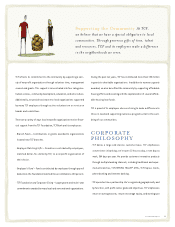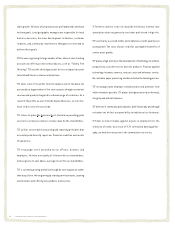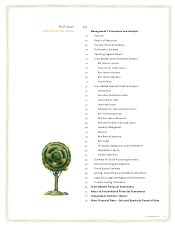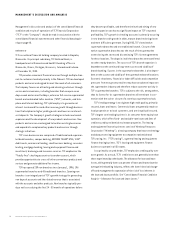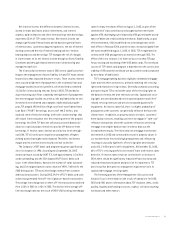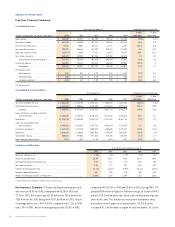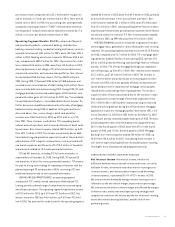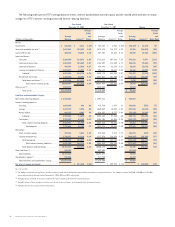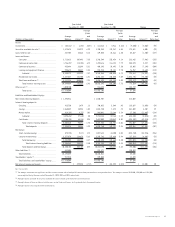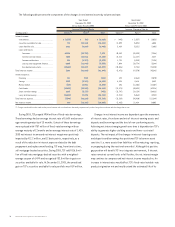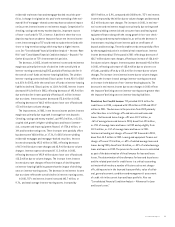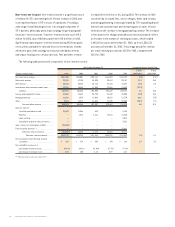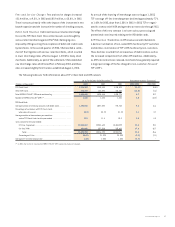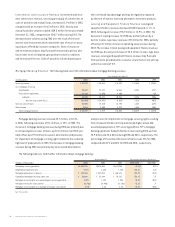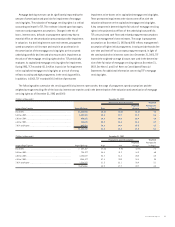TCF Bank 2003 Annual Report Download - page 21
Download and view the complete annual report
Please find page 21 of the 2003 TCF Bank annual report below. You can navigate through the pages in the report by either clicking on the pages listed below, or by using the keyword search tool below to find specific information within the annual report.
2003 Annual Report 19
Net interest income, the difference between interest income,
earned on loans and leases and on investments, and interest
expense, paid on deposits and short-term and long-term borrowings,
represents 53.4% of TCF’s total revenue. Net interest income can
change significantly from period to period based on general levels
of interest rates, customer prepayment patterns, the mix of interest
earning assets and the mix of interest bearing and non-interest
bearing deposits and borrowings. TCF manages the risk of changes
in interest rates on its net interest income through an Asset/Liability
Committee and through related interest rate risk monitoring and
management policies.
The historically low interest rates in 2003 were a significant chal-
lenge to the management of asset/liability risk and TCF made several
key decisions that impacted the year’s results. These very low interest
rates caused a high level of prepayment in the residential loan and
mortgage-backed securities portfolio, which declined a combined
$1.5 billion in total during the year. Early in 2003, TCF decided to
stop reinvesting cash flows created by the high level of prepayments
into new mortgage-backed securities as the available yields on new
investments were deemed unacceptable. Additionally during the
year, TCF prepaid $954 million of high cost fixed-rate Federal Home
Loan Bank (“FHLB”) borrowings, at a cost of $44.3 million, and
replaced some of these borrowings with lower cost borrowings that
will reduce interest expense over the remaining term of the prepaid
borrowings into 2004. TCF does not utilize any unconsolidated sub-
sidiaries or special purpose entities to provide off-balance sheet
borrowings. If interest rates continue at similar low levels through-
out 2004, TCF will continue to experience prepayments of higher
yielding assets that might not be replaced. Therefore, net interest
margin and net interest income would continue to decline.
The Company’s VISA®debit card program has grown significantly
since its inception in 1996. According to a September 30, 2003
statistical report issued by VISA®
, TCF, with approximately 1.5 million
cards outstanding, was the 12th largest VISA®Classic debit card
issuer in the United States, based on the number of cards outstand-
ing, and 11th largest based on sales volume of $998.7 million for the
2003 third quarter. TCF earns interchange revenue from customer
debit card transactions. During 2003, 90.9% of TCF’s debit card sales
volume was generated from off-line (signature-based) transactions.
The average interchange rate on these off-line transactions declined
from 1.55% in 2002 to 1.43% in 2003. The decline in the average off-
line interchange rate was the result of VISA®USA lowering interchange
rates for many merchants effective August 1, 2003, as part of the
settlement of class action lawsuits brought by these merchants
against VISA challenging rules imposed by VISA governing the accep-
tance of debit and credit cards by merchants. Additionally, as part
of the settlement, VISA established new interchange rates which
took effect in February 2004, and these rates increased slightly from
the rates established August 1, 2003. In 2003, TCF renegotiated its
contract with VISA and agreed to an extension through 2013. The
effect of this new contract is to lower various costs that TCF pays
for processing and marketing of the VISA debit cards. The continued
success of TCF’s debit card program is dependent on the success and
viability of VISA and the continued use by customers and acceptance
by merchants of debit cards.
TCF’s mortgage banking business originates residential mortgage
loans and sells them to investors, primarily retaining the servicing
rights and related servicing revenue. Generally accepted accounting
principles require TCF to record the value of the servicing rights on
the balance sheet at the time the loans are sold. Capitalized servic-
ing rights are amortized based on the expected pattern and life of
related servicing revenues and are also evaluated quarterly for
impairment. As interest rates fall, there is a higher probability of
prepayment as the customer can generally refinance the loan with
relative ease. In addition, as property values increase, customers’
home equity increases, enabling customers to engage in “cash-out”
refinance transactions where the customer refinances an existing
mortgage into a higher balance loan in order to draw out the
increased home equity. The historically low mortgage interest rate
environment in 2003 and continued increases in property values in
our markets led to historically high prepayments and refinancing
resulting in unusually high levels of servicing rights amortization
and a $21.2 million provision for impairment. At December 31, 2003,
60% of TCF’s servicing portfolio consisted of loans with interest rates
below 6%. If interest rates remain at current levels or increase in
2004, there should be significantly reduced refinance activity and
reduced related amortization and provision for impairment. TCF
does not utilize derivatives to manage the impairment risk in its
capitalized mortgage servicing rights.
The following portions of the Management’s Discussion and
Analysis focus in more detail on the results of operations for 2003,
2002 and 2001 and on information about TCF’s balance sheet, credit
quality, liquidity and funding resources, capital, critical accounting
estimates and other matters.








